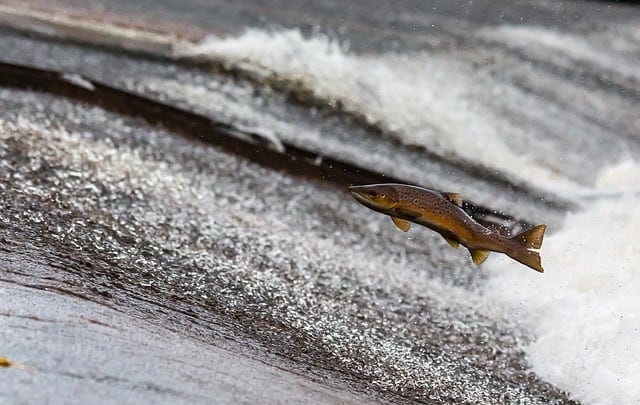
Which is healthier: Wild Salmon vs Farmed Raised Salmon?
Judging nutritional quality of fish at the seafood counter can be difficult, especially when it comes to salmon. You likely have heard of the terms “wild salmon” and “farmed salmon,” but may have little knowledge on their differences between them. And are there any differences nutritionally?
Think of salmon sort of like onions. Salmon doesn’t make you cry like onions but the similarities are that you can buy onions grown on a farm at the grocery store but you can also find them in the wild. Yet, both types of onions are very different. When at the grocery store, you may have seen some salmon labeled “farm-raised” and some labeled “wild” or wild-caught.” Both of them are salmon but how are they different?
Farm-raised salmon
Generally this means the salmon has been raised in some kind of aquatic farming and not in the wild. Salmon farms vary in size, location, and breeding practice. This type of salmon is more fatty, mild in flavor, and has a soft pink-orange hue. It also has plenty of stripey striations of fat, which creates big fleshy flakes that separate easily with a fork.
Wild-caught salmon
This is the real deal type of salmon that is caught in the wild blue. Fishermen take their boats, usually to places on the Pacific ocean like Alaska or New Zealand, and head out to catch salmon in their natural habitat. Wild salmon has more of a salmony flavor and color. The color will be more intense and vibrant than farm-raised salmon – more red-orange than pink – and the flavor will be a lot more savory and complex.
Nutritional content comparison between wild-caught and farm-raised salmon
There are some key differences between wild and farmed salmon. A small fillet of wild salmon has 131 fewer calories and half the fat content of the same amount of farmed salmon. Although farmed salmon may have slightly more of the heart healthy omega-3 fatty acids, it also has 20.5 percent more of the unhealthy saturated fat content. Therefore, nutritionally, wild salmon has a healthier edge for having fewer calories and less saturated fat than farmed salmon.
Other factors to consider
Pollutants – A type of pollutant called persistent organic pollutants (PCPs), are five to 10 times more prevalent in farmed fish than wild salmon. PCPs have been linked to several disease, including type 2 diabetes and obesity. Evidence suggests obesity might be even more of a risk factor for diabetes when PCPs are present in your body and specific types of PCPs increase the risk of stroke in women.
A type of pollutant called persistent organic pollutants (PCPs), are five to 10 times more prevalent in farmed fish than wild salmon. PCPs have been linked to several disease, including type 2 diabetes and obesity. Evidence suggests obesity might be even more of a risk factor for diabetes when PCPs are present in your body and specific types of PCPs increase the risk of stroke in women.
Related: Foods for Younger Looking Skin
Cancer causing chemicals – Even though both farmed and wild salmon offer omega-3 fatty acids, eating large amounts of either type of fish to get their full benefits could expose you to cancer-causing chemicals. These chemicals come from the potentially polluted water fish swim in. That’s why your omega-3 sources need to be broad, with fish as only piece of the puzzle. Basically, eat both types of salmon in moderation, even though wild salmon will be safer.
Unsafe contaminants – In recent studies, contaminants in farmed salmon were generally higher than in wild salmon. Contaminants were below the approved U.S. Food and Drug Administration tolerance levels but still exceeded the levels considered safe for “frequent consumption” by the Environmental Protection Agency. Other research has also suggested that children, women of child-bearing age and pregnant women should choose wild salmon or other sources of omega-3 fatty acids.
Concern over antibiotics – At one time there was much concern over the use of antibiotics in farmed salmon. Today, antibiotics in farmed salmon have been reduced but it is unclear just how much use is still occurring.
Bottom line
When comparing farmed raised and wild salmon, both do contain nutrients we need for good health. But when you do a side-by-side comparison, it is clearer that the risks associated with farmed fish are higher than concerns over wild-caught salmon. Therefore, to get the best health benefits that salmon provides, go wild over wild-caught salmon, choosing it more often.
Read Next: Is Peanut Butter Healthy for Your Family?
